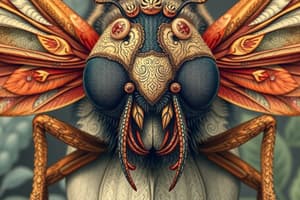Podcast
Questions and Answers
What are the 5 main mouthparts of an insect?
What are the 5 main mouthparts of an insect?
Labrum, Mandibles, Maxillae, Labium, Hypopharynx
Which of the following is NOT a type of insect mouthpart?
Which of the following is NOT a type of insect mouthpart?
- Maxillae
- Palpiger
- Labrum
- Antennae (correct)
Match the type of insect mouthpart with its function.
Match the type of insect mouthpart with its function.
Labrum = Upper lip Mandibles = For chewing and grinding Maxillae = Used for manipulating food and tasting Labium = Lower lip Hypopharynx = Tongue-like structure for tasting and swallowing
Which insect mouthparts are present in both biting and chewing insects and piercing and sucking insects?
Which insect mouthparts are present in both biting and chewing insects and piercing and sucking insects?
The housefly's mouthparts are classified as biting and chewing.
The housefly's mouthparts are classified as biting and chewing.
The insect order Hymenoptera, like honeybees, typically have asymmetrical mouthparts with a right mandible absent.
The insect order Hymenoptera, like honeybees, typically have asymmetrical mouthparts with a right mandible absent.
Which mouthpart type is used by insects to suck liquid food by using a styletle?
Which mouthpart type is used by insects to suck liquid food by using a styletle?
Which of the following insect orders commonly exhibits larva stages known as caterpillars?
Which of the following insect orders commonly exhibits larva stages known as caterpillars?
What type of mouthparts are used by the naiad of a dragonfly ?
What type of mouthparts are used by the naiad of a dragonfly ?
Flashcards
Labrum
Labrum
The upper lip of an insect, often paired.
Mandibles
Mandibles
The primary jaws of insects, used for chewing and biting. They are usually paired.
Maxillae
Maxillae
The secondary jaws of insects. They assist in handling food and often have sensory palps. They are usually paired.
Labium
Labium
Signup and view all the flashcards
Hypopharynx
Hypopharynx
Signup and view all the flashcards
Biting & Chewing
Biting & Chewing
Signup and view all the flashcards
Piercing & Sucking
Piercing & Sucking
Signup and view all the flashcards
Sponging
Sponging
Signup and view all the flashcards
Siphoning
Siphoning
Signup and view all the flashcards
Rasping & Sucking
Rasping & Sucking
Signup and view all the flashcards
Chewing & Lapping
Chewing & Lapping
Signup and view all the flashcards
Caterpillar
Caterpillar
Signup and view all the flashcards
Grub
Grub
Signup and view all the flashcards
Maggot
Maggot
Signup and view all the flashcards
Naiad
Naiad
Signup and view all the flashcards
Nymph
Nymph
Signup and view all the flashcards
Mandibulate
Mandibulate
Signup and view all the flashcards
Haustella
Haustella
Signup and view all the flashcards
Study Notes
Mouthparts
- Mouthparts are structures used for feeding
- Labrum (upper lip)
- Mandible (jaw/1st jaw, lower jaw)
- Maxillae (and lower/false jaw)
- Labium (lower lip)
- Hypopharynx (tongue-like structure)
Types of Mouthparts
-
Biting and Chewing:
- Examples include grasshoppers, locusts, and cockroaches.
-
Piercing and Sucking:
- Examples include mosquitos and bugs; mouthparts are called stylets
- Housefly mandibles are absent.
-
Sponging:
-
Example includes houseflies
-
Mouthparts are modified to absorb liquids.
-
Siphoning:
- Examples include butterflies and moths.
- Maxillary palps and labia are modified for sucking flower nectar
-
Rasping and Sucking:
- Examples include thrips
-
Chewing and Lapping:
- Examples include honeybees
-
Piercing and Sucking: Example includes some beetles
-
Degenerate type:
- Examples include maggots.
- The mouthparts are not fully developed
-
Masked type:
- Examples include naiads of dragonflies
- The mouthparts are modified for catching prey
Feeding Mechanisms
- Mandibulate: Solid foods; mandibles are used to crush food.
- Haustellate: Liquid foods; mouthparts such as stylets for sucking are used to suck up liquids
- Various larval forms have specific mouthpart modifications.
Larval Forms and Insects
- Lepidotera: Caterpillars
- Coleoptera: Grub
- Diptera: Maggot
- Odonata: Naiad
- Hemiptera: Nymph
Studying That Suits You
Use AI to generate personalized quizzes and flashcards to suit your learning preferences.




